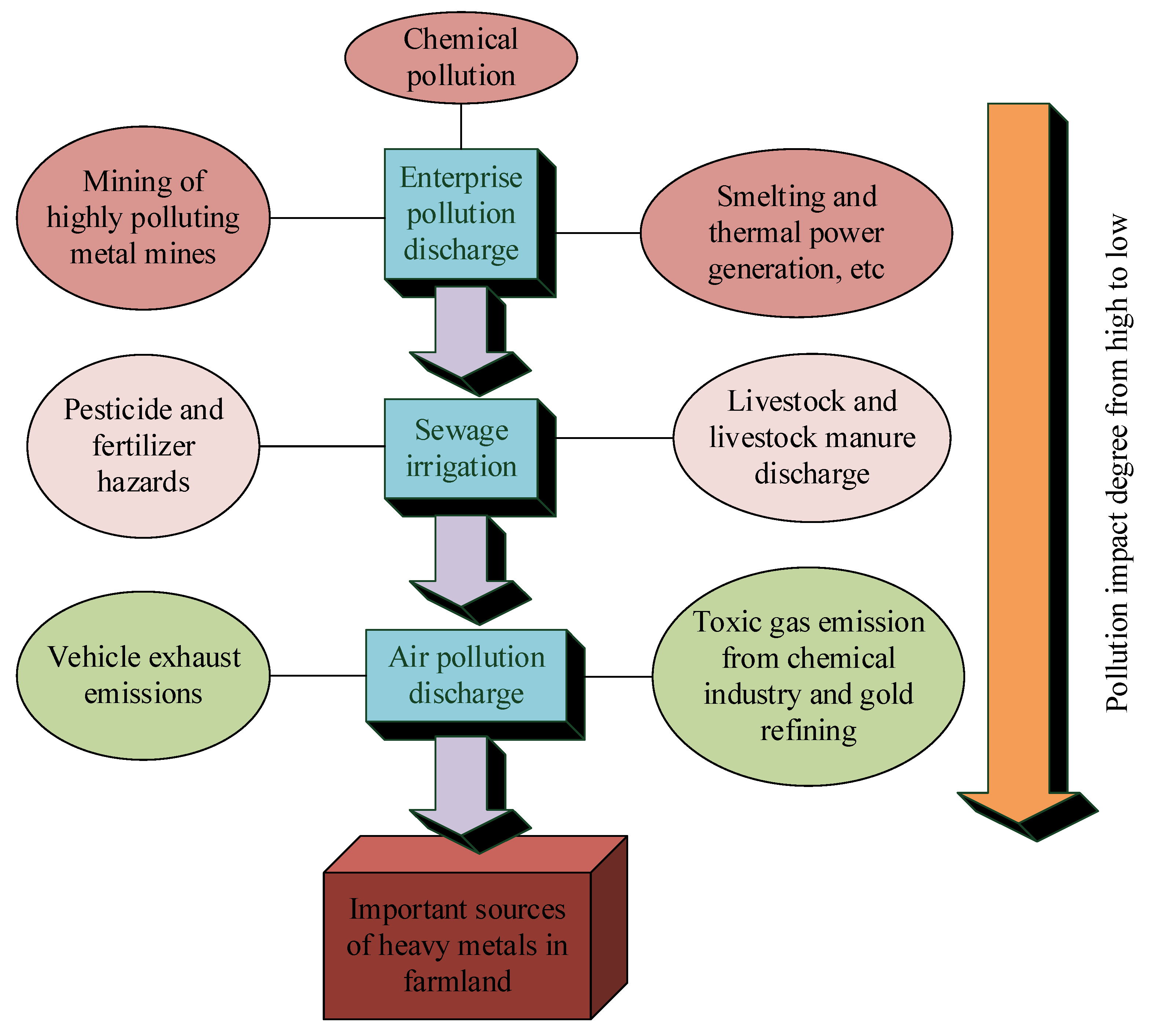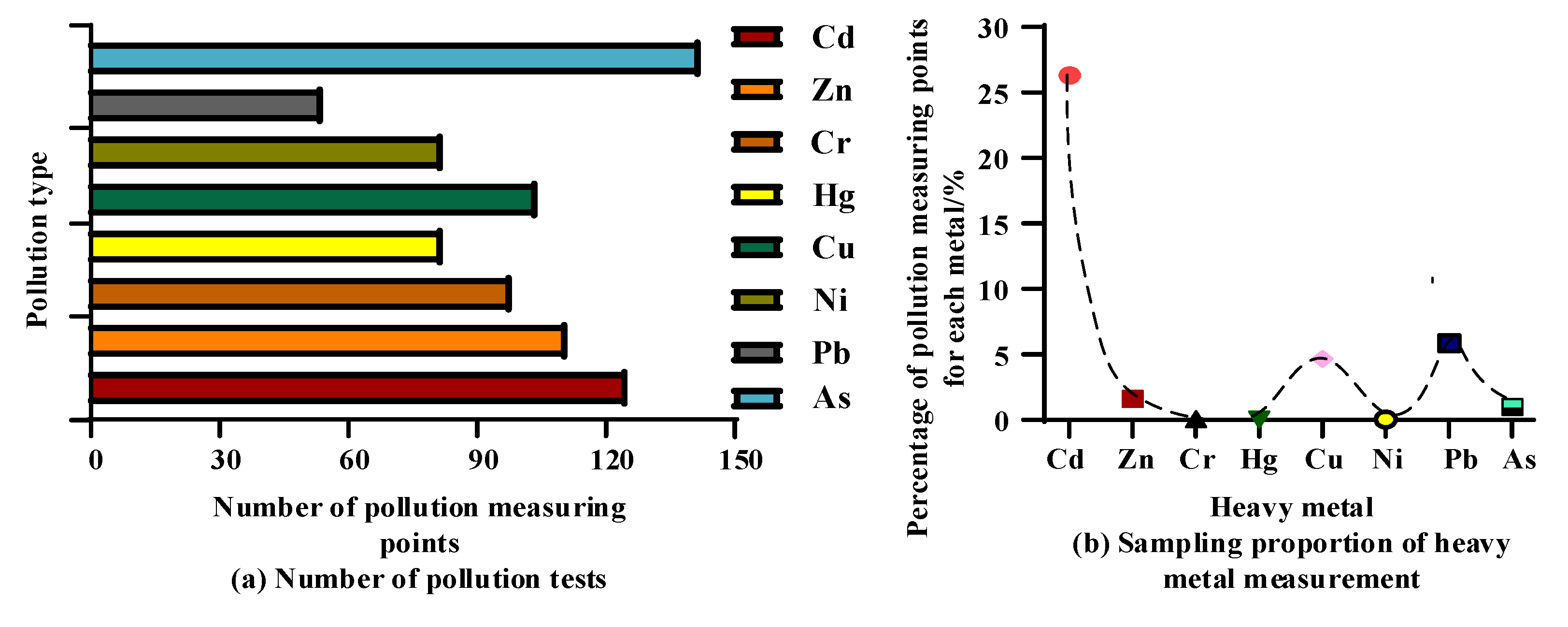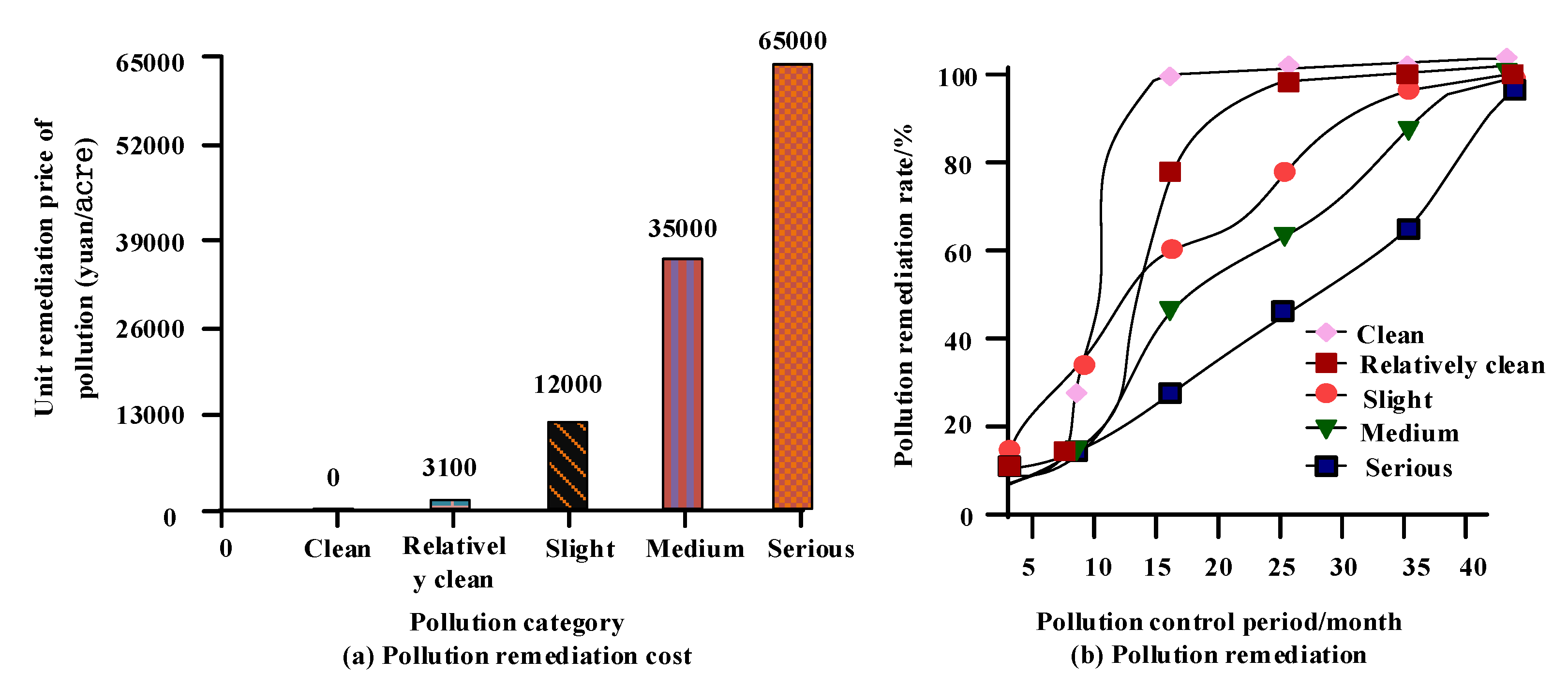Research on Restoration of Heavy Metal Contaminated Farmland Based on Restoration Ecological Compensation Mechanism
Abstract
1. Introduction
2. Ecological Compensation Theory Research and Heavy Metal Farmland Pollution Grade Evaluation
2.1. Research on Ecological Compensation Theory
2.2. Definition of Heavy Metal Farmland Pollution
3. Construction of Ecological Compensation Framework for Heavy Metal Polluted Farmland
3.1. Investigation on Compensation of Heavy Metal Polluted Farmland Users
3.2. Construction of Farmers’ Ecological Compensation Intention Model
3.3. Compensation Standard
3.4. Ecological Compensation Scheme for Farmers
4. Case Analysis
4.1. Specific Cases
4.2. Opinions on the Control of Heavily Polluted Farmland
4.3. Discussion
5. Conclusions
Author Contributions
Funding
Institutional Review Board Statement
Informed Consent Statement
Data Availability Statement
Conflicts of Interest
References
- He, J.; Wan, Y.; Tang, Z.; Zhu, X. A developed framework for the multi-district ecological compensation standards integrating ecosystem service zoning in an urban area in China. Sustainability 2019, 11, 4876. [Google Scholar] [CrossRef]
- Baker, M.; Domanski, A.; Hollweg, T.; Murray, J.; Lane, D.; Skrabis, K.; Taylor, R.; Moore, T.; DiPinto, L. Restoration scaling approaches to addressing ecological injury: The habitat-based resource equivalency method. Environ. Manag. 2020, 65, 161–177. [Google Scholar] [CrossRef] [PubMed]
- Deng, C.; Zhang, S.; Lu, Y.; Li, Q. Determining the ecological compensation standard based on forest multifunction evaluation and financial net present value analysis: A case study in southwestern Guangxi, China. J. Sustain. For. 2020, 39, 730–749. [Google Scholar] [CrossRef]
- Yu, S.; Cui, B.; Xie, C.; Ma, X.; Ning, Z. Ecological offsetting in China's coastal wetlands: Existing challenges and strategies for future improvement. Chin. Geogr. Sci. 2019, 29, 202–213. [Google Scholar] [CrossRef]
- Lv, C.; Ling, M.; Wu, Z.; Cao, Q. Quantitative assessment of ecological compensation for groundwater overexploitation based on emergency theory. Environ. Geochem. Health 2020, 42, 733–744. [Google Scholar] [CrossRef]
- Meng, Y.; Liu, M.; Guan, X.; Liu, W. Comprehensive evaluation of ecological compensation effect in the Xiaohong River Basin, China. Environ. Sci. Pollut. Res. 2019, 26, 7793–7803. [Google Scholar] [CrossRef]
- Wu, W. The reform of the compensation system for ecological and environmental damage in China. Nat. Resour. J. 2020, 60, 63–102. [Google Scholar]
- Cao, S.; Xia, C.; Li, W.; Xiao, L. Win–win path for ecological restoration. Land Degrad. Dev. 2021, 32, 430–438. [Google Scholar] [CrossRef]
- Martin, R.; Schlüter, M.; Blenckner, T. The importance of transient social dynamics for restoring ecosystems beyond ecological tipping points. Proc. Nat. Acad. Sci. USA 2020, 117, 2717–2722. [Google Scholar] [CrossRef]
- Hao, H.; Li, Y.; Zhang, H.; Zhai, R.; Liu, H. Spatiotemporal variations of vegetation and its determinants in the National Key Ecological Function Area on Loess Plateau between 2000 and 2015. Ecol. Evol. 2019, 9, 5810–5820. [Google Scholar] [CrossRef]
- Kangas, J.; Ollikainen, M. Economic insights in ecological compensations: Market analysis with an empirical application to the Finnish economy. Ecol. Econ. 2019, 159, 54–67. [Google Scholar] [CrossRef]
- Kariuki, J.; Birner, R. Exploring Gender Equity in Ecological Restoration: The Case of a Market-Based Program in Kenya. Ecol. Restor. 2021, 39, 77–89. [Google Scholar] [CrossRef]
- Strassburg, B.N.; Beyer, H.L.; Crouzeilles, R. Strategic approaches to restoring ecosystems can triple conservation gains and halve costs. Nat. Ecol. Evol. 2019, 3, 62–70. [Google Scholar] [CrossRef]
- Mansourian, S. Disciplines, sectors, motivations and power relations in Forest Landscape Restoration. Ecol. Restor. 2021, 39, 16–26. [Google Scholar] [CrossRef]
- Lovelock, C.E.; Brown, B.M. Land tenure considerations are key to successful mangrove restoration. Nat. Ecol. Evol. 2019, 3, 1135. [Google Scholar] [CrossRef] [PubMed]
- Zhou, L.; Wang, X.; Wang, Z.; Zhang, X.; Chen, C.; Liu, H. The challenge of soil loss control and vegetation restoration in the karst area of southwestern China. Int. Soil Water Conserv. Res. 2020, 8, 26–34. [Google Scholar] [CrossRef]
- De Matos, T.P.V.; De Matos, V.P.V.; De Mello, K.; Valente, R.A. Protected areas and forest fragmentation: Sustainability index for prioritizing fragments for landscape restoration. Geol. Ecol. Landsc. 2021, 5, 19–31. [Google Scholar] [CrossRef]
- Anderson, D.L.; Rooney, R.C. Differences exist in bird communities using restored and natural wetlands in the Parkland region, Alberta, Canada. Restor. Ecol. 2019, 27, 1495–1507. [Google Scholar] [CrossRef]
- Chazdon, R.L. Creating a culture of caretaking through restoring ecosystems and landscapes. One Earth 2020, 3, 653–656. [Google Scholar] [CrossRef]
- Gerwing, T.G.; Plate, E. Effectiveness of nutrient enhancement as a remediation or compensation strategy of salmonid fisheries in culturally oligotrophic lakes and streams in temperate climates. Restor. Ecol. 2019, 27, 279–288. [Google Scholar] [CrossRef]
- Clark, C.; Nyaupane, G.P. Connecting landscape-scale ecological restoration and tourism: Stakeholder perspectives in the great plains of North America. J. Sustain. Tour. 2022, 30, 2595–2613. [Google Scholar] [CrossRef]
- Long, R. Restoring marine environmental damage: Can the Costa Rica v Nicaragua compensation case influence the BBNJ negotiations? Rev. Eur. Comp. Int. Environ. Law 2019, 28, 244–257. [Google Scholar] [CrossRef]
- Liu, L.; Zeng, K.; Wu, N.; Zhang, X.; Sun, F. Variation in physicochemical and biochemical soil properties among different plant species treatments early in the restoration of a desertified alpine meadow. Land Degrad. Dev. 2019, 30, 1889–1903. [Google Scholar] [CrossRef]
- Ouyang, Z.; Song, C.; Zheng, H.C.G. Using gross ecosystem product (GEP) to value nature in decision making. Proc. Nat. Acad. Sci. USA 2020, 117, 14593–14601. [Google Scholar] [CrossRef]
- Becker, N.; Gross, Y.; Lavee, D. Cost–benefit analysis of restoring an ephemeral desert stream after an ecological accident. Water Policy 2022, 22, 328–347. [Google Scholar] [CrossRef]
- Hu, D.; Liu, H.; Chen, X.; Chen, Y. Research on the ecological compensation standard of the basin pollution control project based on evolutionary game theory and by taking Xiangjiang River as a case. Front. Eng. Manag. 2019, 6, 575–583. [Google Scholar] [CrossRef]
- Buitenhuis, Y.; Dieperink, C. Governance conditions for successful ecological restoration of estuaries: Lessons from the Dutch Haringvliet case. J. Environ. Plan. Manag. 2019, 62, 1990–2009. [Google Scholar] [CrossRef]
- Wei, C.; Liu, H.; Lv, J. Preliminary Study on the Ecological Compensation of the Primary and Secondary Reserves in Drinking Water Source Area of the Shitoukoumen Reservoir. Meteorol. Environ. Res. 2020, 11, 12–20. [Google Scholar]
- Hu, Y.; Huang, J.; Hou, L. Impacts of the grassland ecological compensation policy on household livestock production in China: An empirical study in Inner Mongolia. Ecol. Econ. 2019, 161, 248–256. [Google Scholar] [CrossRef]
- Li, X.; Wang, Y.; Yang, R. From “blood transfusion” to “hematopoiesis”: Watershed eco-compensation in China. Environ. Sci. Pollut. Res. 2022, 29, 49583–49597. [Google Scholar] [CrossRef] [PubMed]
- Fan, M.; Chen, L.; Wang, Q. Assessing the high impacts of land use change: Spatial characteristics of land uses and ecological compensation based on payment for ecosystem services model in a mountainous area, China. Mitig. Adapt. Strat. Glob. Chang. 2019, 24, 1431–1460. [Google Scholar] [CrossRef]
- Shanshan, J.; Yanqing, Z. Ecological compensation method for soil polluted by heavy metals based on internet of things. Earth Sci. Res. J. 2020, 24, 153–161. [Google Scholar] [CrossRef]
- Yang, Q.; Nan, Z.; Tang, Z. Influencing factors of the grassland ecological compensation policy to herdsmen's behavioral response: An empirical study in Hexi corridor. Acta Ecol. Sin. 2022, 42, 74–79. [Google Scholar] [CrossRef]
- Xu, J.; Xiao, Y.; Xie, G.; Yuan, J. Ecosystem service flow insights into horizontal ecological compensation standards for water resource: A case study in Dongjiang Lake basin, China. Chin. Geogr. Sci. 2019, 29, 214–230. [Google Scholar] [CrossRef]
- Liu, W.; Hughes, A.C.; Bai, Y. Using landscape connectivity tools to identify conservation priorities in forested areas and potential restoration priorities in rubber plantation in Xishuangbanna, Southwest China. Land. Ecol. 2020, 35, 389–402. [Google Scholar] [CrossRef]
- Wei, X.G.; Liu, H.L.; Li, G.H. Influencing Factors of Eco-Environmental Safety of Mines and Their Green Development: A Case Study of Taoshan Coal Mine in Heilongjiang Province, China. Nat. Environ. Pollut. Technol. 2020, 19, 831–838. [Google Scholar]
- Jiang, D.; Chen, Z.; Mcneil, L.; Dai, G. The game mechanism of stakeholders in comprehensive marine environmental governance. Mar. Policy 2019, 112, 103728. [Google Scholar] [CrossRef]
- Xi, B.; Jing, H. Research on horizontal compensation of ecological economic benefits under differential responsibility. Environ. Sci. Pollut. Res. 2021, 28, 29875–29889. [Google Scholar] [CrossRef]
- Patterson, C.; Torres, A.; Coroi, M. Treatment of ecological connectivity in environmental assessment: A global survey of current practices and common issues. Impact Assess. Proj. Apprais. 2022, 40, 460–474. [Google Scholar] [CrossRef]
- Bu, Y.; Wang, E.; Yu, Y. Analysis on asymptotic stabilization of eco-compensation program for forest ecotourism stakeholders. Environ. Sci. Pollut. Res 2021, 28, 29304–29320. [Google Scholar] [CrossRef] [PubMed]




| Pollution Levels | Pollution Status | Pollution Evaluation Index | Farmland Quality |
|---|---|---|---|
| Level one | clean | p ≤ 0.7 | In safe and healthy condition |
| Secondary | Relatively clean | 0.7 < p ≤ 1 | Relatively safe, but on the verge of pollution |
| Level three | Slight | 1 < p ≤ 2 | Heavy metals in farmland soil obviously exceed the safe value, and plant growth is affected to a certain extent |
| Level 4 | Medium | 2 < p ≤ 3 | Farmland soil, microorganisms, plant growth restriction |
| Fifth grade | Serious | p > 3 | Plants die, soil is heavily polluted |
| Heavy Metal | Farmland Type | Level One | Secondary | Level Three | |
|---|---|---|---|---|---|
| Farmland Environment Background | 6.5 ≤ pH ≤ 7.5 | pH > 6.5 | |||
| Cd | Paddy field, farmland, orchard field, dry field | ≤ | 0.20 | 0.3 | 1 |
| Hg | ≤ | 0.15 | 0.5 | 1.5 | |
| As | ≤ | 15 | 25 | 30 | |
| Cu | ≤ | 35 | 100 | 400 | |
| Cr | ≤ | 90 | 300 | 400 | |
| Pb | ≤ | 90 | 200 | 300 | |
| Zn | ≤ | 100 | 250 | 500 | |
| Ni | ≤ | 40 | 50 | 200 | |
| Variable Factors | Factor Name | Assign Value 1 | Assign Value 0 |
|---|---|---|---|
| X1 | Annual income of agricultural personnel | Annual income higher than 30,000 | Annual income less than 30,000 |
| X2 | Homework workforce | More than two people | Less than two people |
| X3 | Political status | Party members and cadres | Non-party members and cadres |
| X4 | Education level | High school or above | Lower than high school |
| X5 | Age | Less than 35 | Greater than 35 |
| X6 | Farmland planting area | More than 5 acres | Less than 5 acres |
| X7 | Farmland pollution survey | Polluted | Unpolluted |
| X8 | Are crops affected | Crop growth is affected | Normal crop growth |
| X9 | Whether to produce crops | Sell crops | Don’t sell crops |
| Classification | Clean | Relatively Clean | Slight | Medium | Serious |
|---|---|---|---|---|---|
| Heavy metal pollution index | p ≤ 0.7 | 0.7 < p ≤ 1 | 1 < p ≤ 2 | 2 < p ≤ 3 | p > 3 |
| Cost (yuan/acre) | 0 | 3050 | 10,050 | 31,000 | 62,000 |
| Heavy Metal | Restoration Plant | Content mg/kg | Estimated Lifespan (Years) |
|---|---|---|---|
| As | Centipede grass | 40 | 3 |
| Cd | Solanum nigrum | 82 | 2 |
| Zn | Sedum | 32 | 1.5 |
| Cu | Indian acrestard greens | 56 | 2.8 |
| Hg | Canada poplar, mangrove | 15 | 2.6 |
| Cr | Jatropha curcas, reeds | 43 | 2.8 |
| Pb | Indian shepherd’s purse | 36 | 4.2 |
| Ecological Compensation Cost | Clean | Relatively Clean | Slight | Medium | Serious |
|---|---|---|---|---|---|
| Polluted area/acre | 0 | 3200 | 800 | 500 | 300 |
| Environmental value (yuan/acre) | 0 | 3100 | 12,000 | 35,000 | 65,000 |
| Opportunity cost | 0 | 1520 | 2150 | 2450 | 3650 |
| Ecological compensation standard (yuan/acre) | 0 | 4550 | 13,200 | 36,000 | 66,000 |
| Ecological compensation amount (million yuan/acre) | 0 | 1300 | 906 | 310 | 124 |
| Final total compensation (million yuan/acre) | 3235 | ||||
Disclaimer/Publisher’s Note: The statements, opinions and data contained in all publications are solely those of the individual author(s) and contributor(s) and not of MDPI and/or the editor(s). MDPI and/or the editor(s) disclaim responsibility for any injury to people or property resulting from any ideas, methods, instructions or products referred to in the content. |
© 2023 by the authors. Licensee MDPI, Basel, Switzerland. This article is an open access article distributed under the terms and conditions of the Creative Commons Attribution (CC BY) license (https://creativecommons.org/licenses/by/4.0/).
Share and Cite
Cai, Z.; Yang, X. Research on Restoration of Heavy Metal Contaminated Farmland Based on Restoration Ecological Compensation Mechanism. Sustainability 2023, 15, 5210. https://doi.org/10.3390/su15065210
Cai Z, Yang X. Research on Restoration of Heavy Metal Contaminated Farmland Based on Restoration Ecological Compensation Mechanism. Sustainability. 2023; 15(6):5210. https://doi.org/10.3390/su15065210
Chicago/Turabian StyleCai, Zheng, and Xiuli Yang. 2023. "Research on Restoration of Heavy Metal Contaminated Farmland Based on Restoration Ecological Compensation Mechanism" Sustainability 15, no. 6: 5210. https://doi.org/10.3390/su15065210
APA StyleCai, Z., & Yang, X. (2023). Research on Restoration of Heavy Metal Contaminated Farmland Based on Restoration Ecological Compensation Mechanism. Sustainability, 15(6), 5210. https://doi.org/10.3390/su15065210








